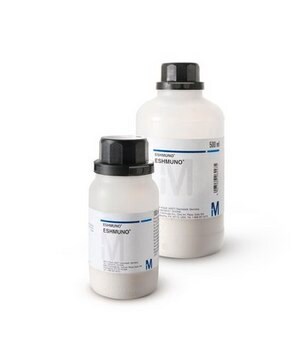1.16883
Fractogel® EMD DEAE (M)
Synonym(s):
Fractogel® EMD DEAE (M)
About This Item
Recommended Products
Quality Level
ligand
diethylaminoethyl
description
weak anion exchanger, suspension in 20% ethanol and 150 mM NaCl (40-90 µm)
sterility
sterile (Caustic Stable)
product line
Fractogel®
form
resin
parameter
170 cm/hr flow rate
8 bar max. pressure
matrix active group
methacrylate
mean particle size
40-90 μm
capacity
100 mg binding capacity (BSA/mg of resin)
Looking for similar products? Visit Product Comparison Guide
General description
Features and Benefits
- Excellent binding to large viruses and plasmid DNA
- Homogenous binding with high selectivity and purity
- Lower elution volumes for the highest purity levels
- Compatibility with 2.5 % (v/v) aqueous benzyl alcohol containing 150 mM NaCl storage solution
Due to the titration behavior, the ion exchange capacity can be used from pH 2 to pH 9.5. The separation of proteins is based on reversible electrostatic interactions between the negatively charged regions of the proteins′ surface and the support. Proteins are retained efficiently on Fractogel® EMD DEAE when the pH of the buffer is about 1 unit above their isoelectric points (pl).
The strength of the binding depends on the following:
- the buffer system
- pH value of the buffer which determines the surface charge of the protein
- the degree of the ionization of the functional groups of the exchanger
- the concentration of the counter ions
- the charge density on the support (protein binding capacity)
Packaging
- 1.16883.0100: Fractogel® EMD DEAE (M) Resin 100ml
- 1.16883.0010: Fractogel® EMD DEAE (M) Resin 10ml
- 1.16883.0500: Fractogel® EMD DEAE (M) Resin 500ml
- 1.16883.5000: Fractogel® EMD DEAE (M) Resin 5L
Analysis Note
Microscopic evaluation: Uniform spherical particles,no agglomerates,no fines
Extractable matter (water): ≤ 0.03 %
Cerium: ≤ 1 µg/g
Pressure drop(column: ID=1.6 cm, L=10 cm at 5 ml/min): ≤ 1 bar
Particle size (d10): 37 - 45 µm
Particle size (d50): 48 - 60 µm
Particle size (d90): 63 - 77 µm
Colony forming units (TAMC + TYMC): ≤ 100 CFU/ml
Endotoxins: ≤ 1.00 EU/ml
Protein binding capacity (bovine serum albumin): 80 - 120 mg/ml
Functional test (b:a): ≤ 0.25
Functional test: Separation of conalbumin and human serum albumin
Legal Information
signalword
Warning
hcodes
Hazard Classifications
Flam. Liq. 3
Storage Class
3 - Flammable liquids
wgk_germany
WGK 3
flash_point_f
95.0 °F
flash_point_c
35 °C
What is the Emprove® Program?
The Emprove® Program is a system providing comprehensive and thorough documentation of our filters and single-use components, pharma raw materials, and starting materials. Four document types are included with an Emprove® Program subscription:
Free of charge - Sign in to download
Free of charge - Sign in to download
Available by subscription or for a fee
Already Own This Product?
Find documentation for the products that you have recently purchased in the Document Library.
Articles
See case study examples of how to optimize chromatographic purification of plasmid DNA for Biopharmaceutical Applications.
Influenza vaccines are commonly made using egg-based and cell-based manufacturing strategies. Find step-by-step information on the manufacturing process for each method.
A custom-designed cost model is used to explore the economics of vaccine manufacturing across several different modalities including mRNA. The model enables greater process understanding, simulates bottlenecks, and helps to optimize production efficiency.
Learn more one the attenuated viral vaccines manufacturing process: cell culture, clarification, nuclease treatment, chromatography, and sterile filtration.
Related Content
This technical article breaks down the adenovirus vaccine manufacturing process and provides a case study on developing an accelerated and cost-effective single-use adenoviral vector vaccine.
This page summarizes key considerations related to regulatory expectations for biomanufacturing including chemicals and polymeric materials. For chemicals, topics include nitrosamines and elemental impurities, and for polymeric materials such as filters and single-use assemblies, the focus is qualification and extractable and leachable testing.
Our team of scientists has experience in all areas of research including Life Science, Material Science, Chemical Synthesis, Chromatography, Analytical and many others.
Contact Technical Service






